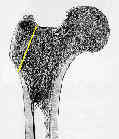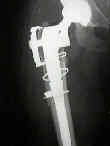- See: Total Hip Replacement Menu:
- Discussion:
- indications for osteotomy:
- considerations for wire re-attachment:
- wires can theoretically undergo gavanic corrosion if they are close to or touch the metal implant;
- this is usually of little significance even if the wires break;
- use chrome-cobalt wires (Vitallium) rather than stainless steel;
- all wires in the greater trochanter tend to break in time even if trochanter is solidly united;
- w/ soft bone (rheumatoid patients), then consider use of wire mesh or plate, which prevents the wire from cutting throught the trochanteric fragment;
- Surgical Technique: 
- release the origin of the vastus lateralis from vastus tubercle;
- osteotomy is performed 1 cm below vastus tubercle, w/ oscillating saw aimed at the junction of the greater trochanter
w/ the femoral neck;
- greater trochanter is subjected to forces in mainly two directions;
- vertical pull of glutei, which tends to pull trochanter proximally
- anterior pull is more troublesome, and the trochanter is subject to this pull every time the hip is flexed;
- vertical resistance:
- two drill holes are made through the peripheral edges of the lateral cortex, (one drill hole is made anteriorly and the
other is made posteriorly);
- the 2 mm drill is directed toward the respective edges of the calcar;
- usually these drill holes are made 2 cm below level of the ostetomy, but in soft bone or when a trochanteric advancement is to be performed,
then it is necessary to place the holes even more inferiorly;
- wires are threaded thru these holes and are then subsequently inserted thru the Sharpy's fibers of the gluteus medius insertion;
- once, all wires have been inserted, a Harris wire tightener is then used to secure the trochanteric fragments with square knots;
- transverse resistance:
- drill hole is made thru the lesser trochanter, and the wire is then brought upwards thru two drill holes made in the trochanteric fragment;
- this wire will prevent transverse motion as well as preventing rotation;
- references:
- A New Technique to Reattach an Extended Trochanteric Osteotomy in Revision THA Using Suture Cord
- Fixation of Chevron Trochanteric Osteotomy With Two Wire Loops In Isolated Acetabular Component Revision
- Sliding Osteotomy Technique:
- Extended Trochanteric Osteotomy:
- Considerations for Cemented Components:
- if possible, reattach the trochanteric fragment (esp w/ extended osteotomy) prior to insertion of the cemented component (otherwise the supero-lateral
portion of the component will not be covered by cement;
- before the osteotomy fragment is tightened, place dry gel foam strips along its edges, inorder to prevent cement from leaking out;
- as suggested by McGory, et al., temporarily placed hose clamps will provide maximal tension while cement hardens and later when cerclage wires are placed;
- Trochanteric Osteotomy for Total Hip Arthroplasty: Six Variations and Indications for their use.
Complications
- Trochanteric Non-Union:
- references:
- Complications of trochanteric osteotomy. Long-term implications.
- Case Report: Superficial Femoral Artery Injury Resulting From Cerclage Wiring During Revision THA
Chevron osteotomy and single wire reattachment of the greater trochanter in primary and revision total hip arthroplasty.
Distal transfer of the greater trochanter.
Primary and revision total hip replacement without cement and with associated femoral osteotomy.
Trochanteric Osteotomy for Total Hip Arthroplasty: Six Variations and Indications for their use.


